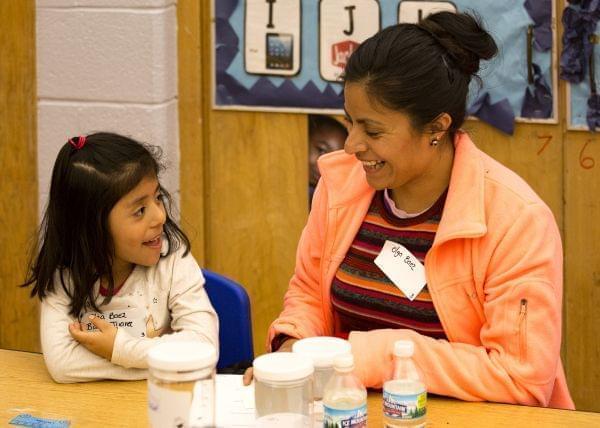Using Play and Positive Attention to Teach Financial Basics to 4 and 5 Year-Olds

A parent interacts with her child during a financial literacy workshop at the Savoy Head Start. Travis Stansel
Children love games. In addition, they love positive attention from the adults in their lives. If you combine these two with a little guidance from Sesame Street’s Finances for Kids, you can help children as young as four years old learn the basics of financial literacy. We know this from direct experience with the families we work with and our own pre-school aged children.
Last week, WILL education staff and our partners from Champaign County Head Start, offered two basic financial literacy activities from the Sesame Street curriculum to families. Parents lead their children in these interactive activities as well as interacted with other families.

In one room, we guided families to think about the differences between wants and needs. We asked on this late November night if a hat might be something they need to keep their head warm. Is protective clothing a want or a need? What about food? Do we need food? Then we split the room into two sections: a wants and a needs section. We named something and then asked the children and their families to go to one corner if they thought that item was a need and another corner if they thought that item was a want. Then we asked families questions such as “Why did you decide that the thing I named is a need and not a want?” “Why would some people think something is a want and others would think it is a need?” Children used different colored crayons to color items on an Elmo coloring sheet to indicate the difference between wants and needs.

Parents liked this game. One wrote in their feedback survey, “I will make sure to teach my son how to save money by using wants and needs.” Another wrote, “Spending a little extra time with them makes them happier.”
The second activity involved choices about money. We provided the families with three clear plastic jars. One jar was for spending, another for saving and a third for sharing. Then they were given stickers labeled “We are saving for,” We are spending on” and “We are sharing with.” Talking with their children, the families came up with one item for each jar and then wrote down three clues for that item. Then the families tried to guess each other’s items. Each family who participated received a quarter for each item and an extra quarter if they guessed the other family’s item. Families got to keep their jars and coins.
Parents enjoyed this activity. One wrote on their feedback survey, “It will be nice to have my child get in the habit of saving money by putting it in the jars instead of trying to put it in her mouth.” Another parent wrote that they will try to “buy only things we really need.”

With a little attention and support, you can teach your very young child about choices and money. Let us know if we can help by emailing us at will-bookmentor@illinois.edu.
This event was supported by PNC Grow Up Great, helping children from birth through age five develop a passion for learning that lasts a lifetime – and can help set them on a path to success.

